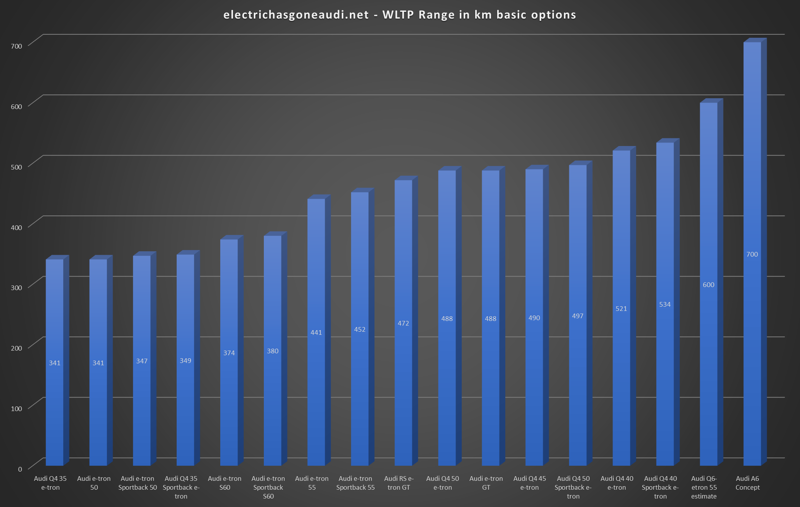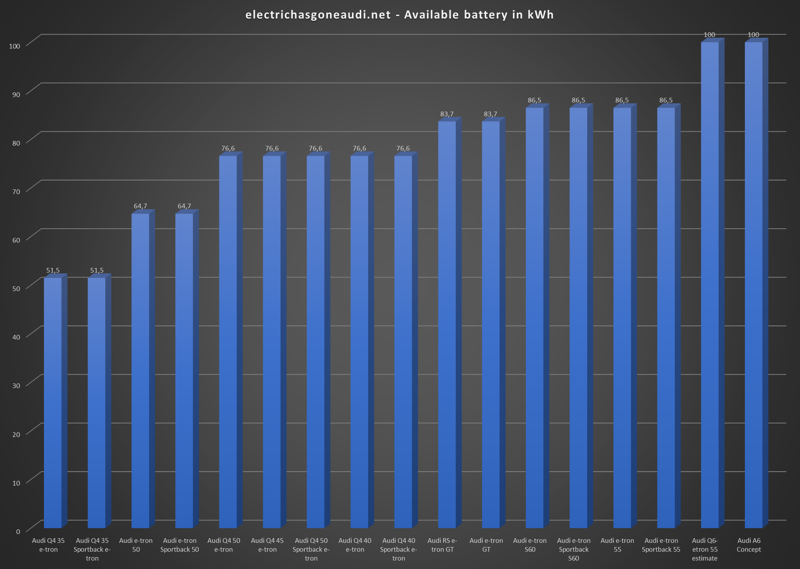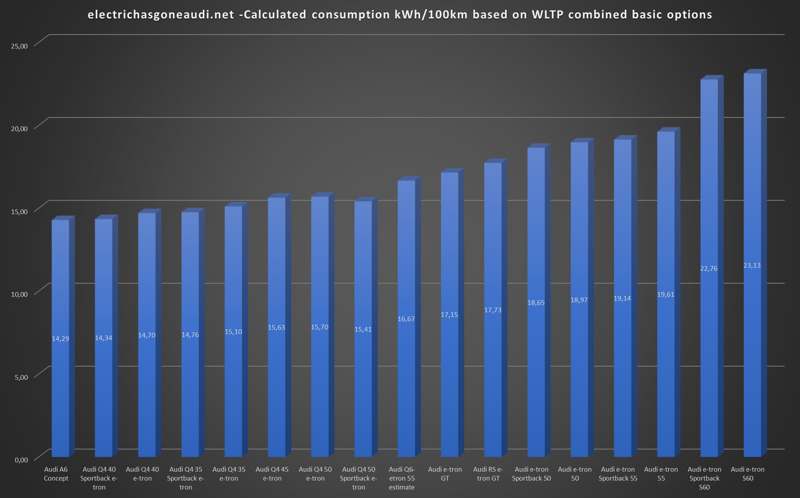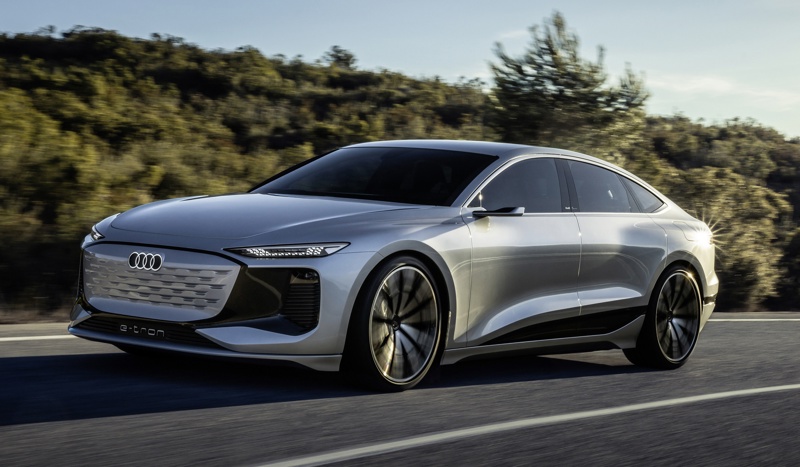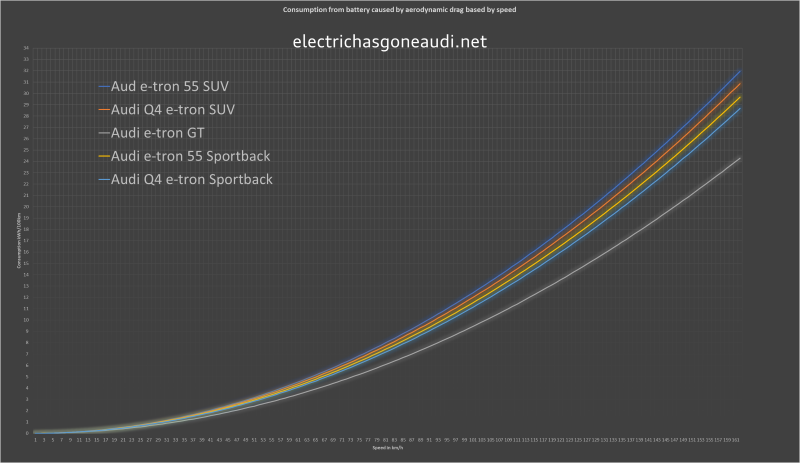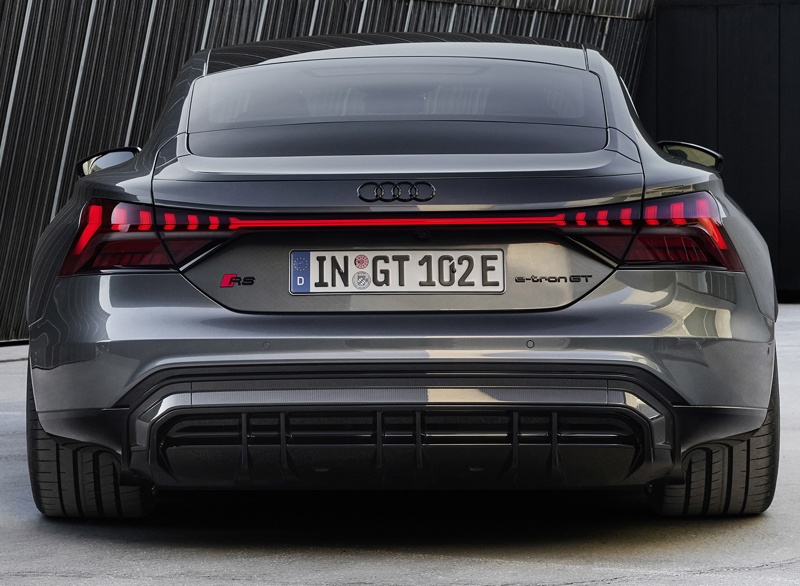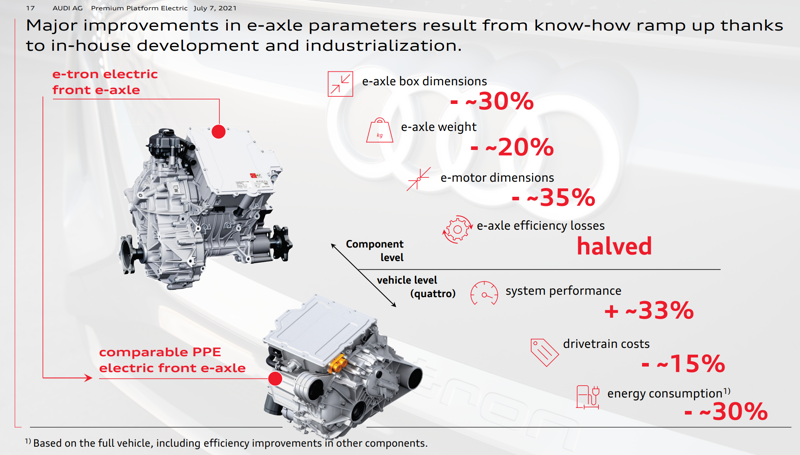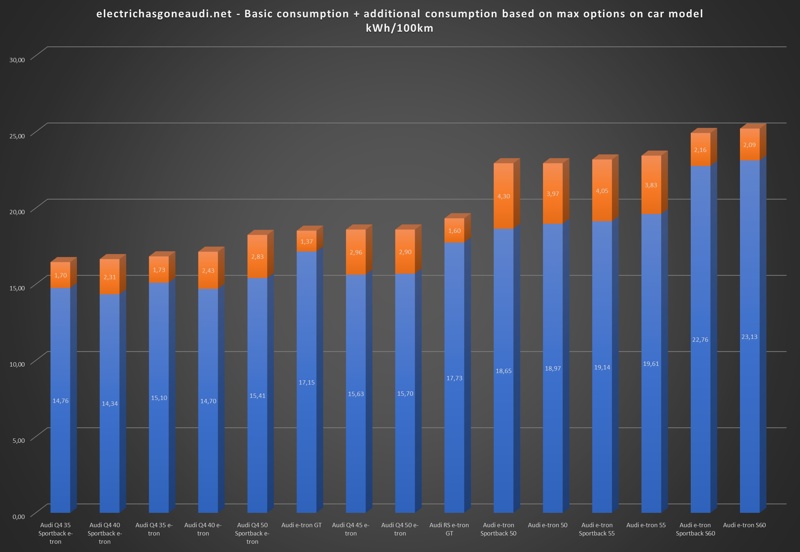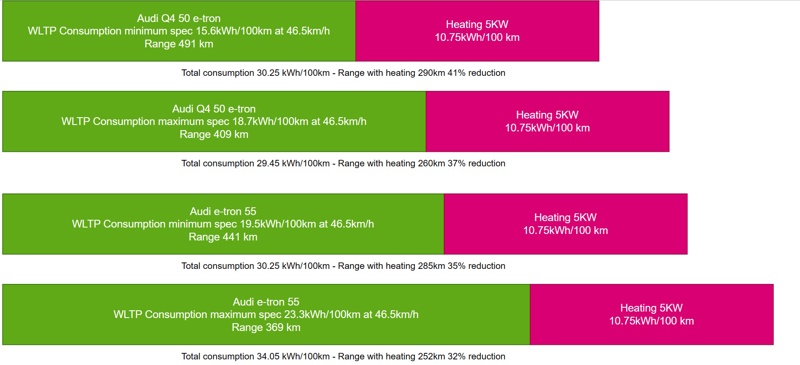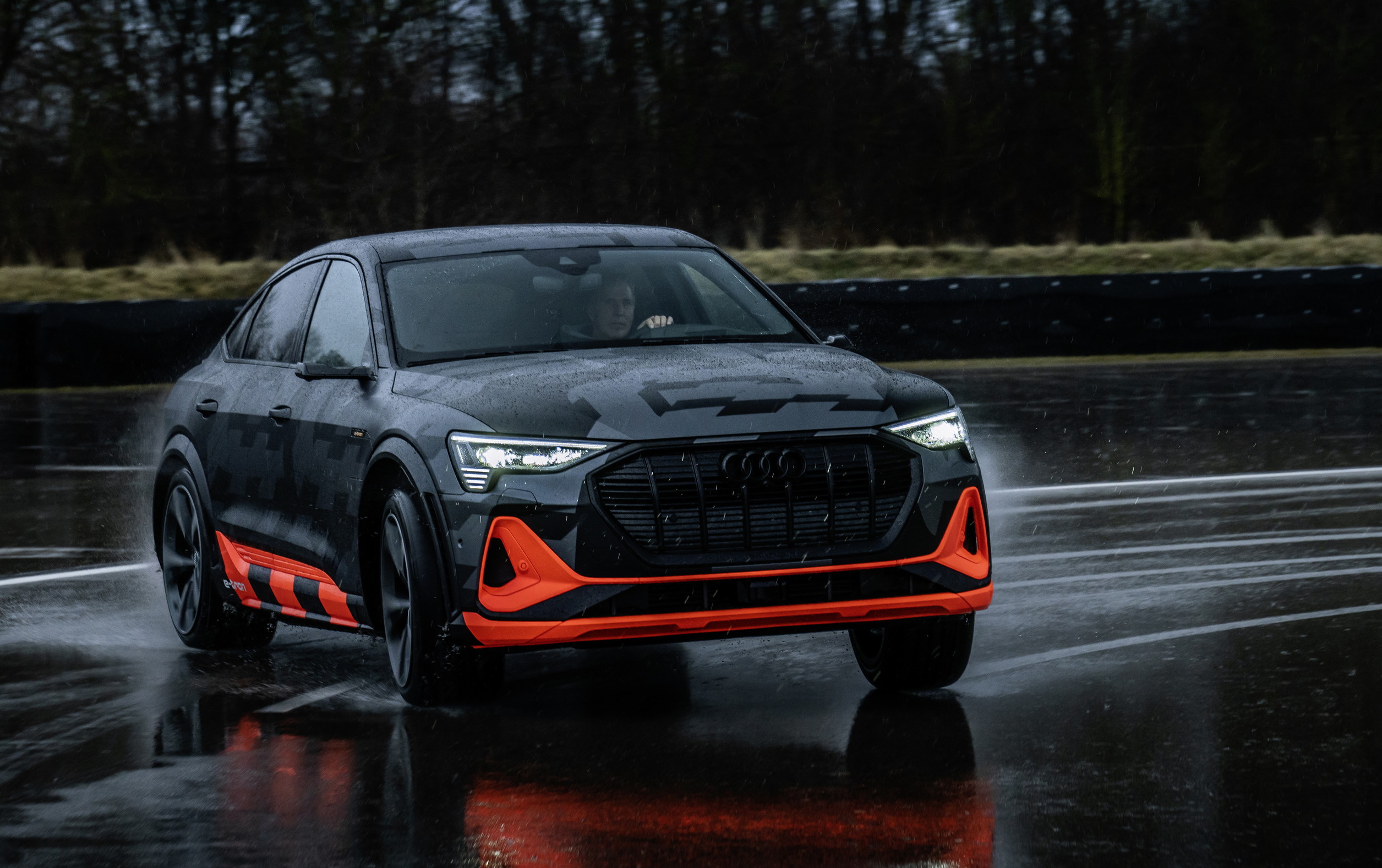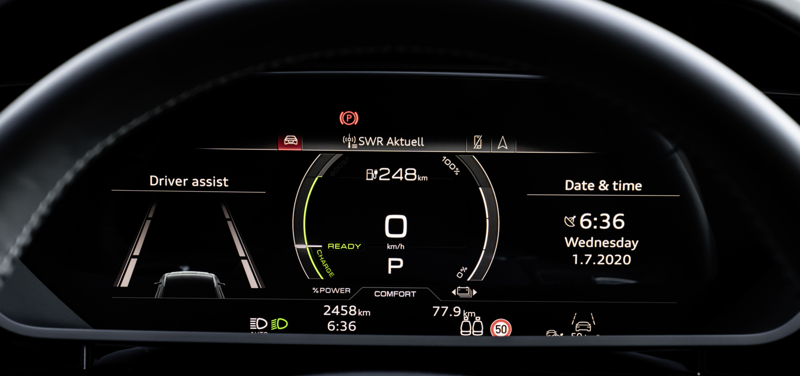Understanding range
For many, the range is the most important aspect of an EV. In this guide, we explain what affects the range of your all-electric Audi and why you don't see the range as expected.
The range of electric cars is typically given as a WLTP range (Worldwide Harmonised Light Vehicles Test Procedure) in Europe or EPA in the US.
Below you see the range of the different current and some future Audi models. The range is from 341km (211 miles) to 700km (435 miles) according to the WLTP combined standard.
WLTP Range all-electric Audis
The most important aspect of range is of course how large the battery is. A larger battery means more energy to use.
The below chart shows the available battery size for the different models.
Available battery all-electric Audis
But the battery is not the only factor in the stated range. Another important factor is how efficient the car is.
And with efficiency, it means how much energy is used from the battery for a given distance. In Europe, it is typical stated as kWh/100km meaning how many kWh is needed to drive 100km. In the US and the UK, it is rated as miles per kWh, meaning how far can you go with 1 kWh.
The below diagram shows the calculated consumption in kWh/100km for the different all-electric models is according to WLTP combined rating.
Calculated consumption kWh/100km
What affects the WLTP consumption?
The efficiency or WLTP consumption is affected by many attributes of the car.
Aerodynamic drag
The aerodynamic drag affects how much energy is needed to move. The shape of the body affects it but also the design of the wheels.
Audi A6 e-tron concept is currently the model with the lowest drag coefficient with a Cw value on only 0.22
Audi A6 e-tron with Cw value of only 0.22
In the below graph you see how much consumption the aerodynamic drag causes for the different model series for Audi.
Consumption caused by aerodynamic dra
Beregnede verdier for forbruk som kun kommer fra aerodynamisk luftmotstand basert på 80 % drivlinjeseffektivitet.
| Speed | Audi e-tron 55 | Audi Q4 e-tron | Audi e-tron GT |
|---|---|---|---|
| 50km/h (31mph) | 3.04kWh/100km | 2.94 kWh/100km | 2.31kWh/100km |
| 80km/h (49.7mph) | 7.79 kWh/100km | 7.52 kWh/100km | 5.92kWh/100km |
| 120km/h (74.6mph) | 17.53kWh/100km | 16.94kWh/100km | 13.33kWh/100km |
Du ser hvordan Audi e-tron GT i høy hastighet sparer mye energi sammenlignet med suven på grunn av mindre aerodynamisk luftmotstand.
Disse verdiene er basert på luftmotstandskoeffisienten og størrelsen på frontområdet til modellene
| Model | Drag coefficient (cd) | Frontal area |
|---|---|---|
| Audi e-tron SUV | 0.28 | 2.65m2 |
| Audi e-tron Sportback | 0.26 | 2.65m2 |
| Audi Q4 e-tron SUV | 0.28 | 2.56m2 |
| Audi Q4 e-tron Sportback | 0.26 | 2.56m2 |
| Audi e-tron GT | 0.24 | 2.35m2 |
| Audi A6 e-tron sportback | 0.22 | ?m2 |
| Audi A6 Avant e-tron sportback | 0.24 | ?m2 |
Rolling resistance
The rolling resistance sometimes called rolling friction or rolling drag is the force resisting the motion when a body (such as a ball, tire, or wheel) rolls on a surface.
This is affected by the width of the tires, the weight of the car, the tire compound, and the tire pressure.
Audi RS e-tron GT has very wide tires with 285mm to get the best traction. This increases rolling resistance. As an option, you can get 305mm wide tires that increase traction and decreases range.
Audi RS e-tron GT with 305mm rear tires
Some tire producers have started producing specific tires for EV with low rolling resistance that affect range.
Audi delivers these types of tires on some of the models. See below for a very good and detailed test that describes the difference between EV optimized tires and regular.
Weight
A heavier car requires more energy to move.
The efficiency of the drivetrain/motors
Electric motors are very efficient by default, but there are still some different technologies that give different consumption based on the setup.
Permanently excited synchronous use less energy in use but have higher coasting resistance. Induction motors use a little more energy to move but have almost zero coasting resistance.
Newer cars often combine these two techniques having a rear synchronous motor always in use and an induction motor in front. Example Audi Q4 e-tron quattro 50.
Audi is working on the new PPE platform and already now we know that this drivetrain will have a improved effiency
PPE Drivetrain
The internal resistance of the battery
The internal resistance in the battery causes heat loss in the battery.
Factors vary based on selected options
Many of the above factors are fixed. Like the e-tron Sportback has less drag than the e-tron SUV because of the body shape.
But other factors are affected by the equipment you add to your car. If you buy wider tires, you will get a higher consumption and then a shorter range.
The below diagram shows hows adding the max options of the car increase the WLTP consumption.
WLTP Consumption added with options
From the diagram, you can see that an Audi e-tron 55 has a consumption of 19.61 kWh/100km in the basic trim, but 23.44 kWh/100km in the top trim. Reducing the range from 441km (274 miles) to 369km (229 miles).
What affects the real-world consumption
In the real world, it is almost impossible to get the same range as given by WLTP or EPA. This is because that range is based on ideal driving conditions with specific behavior.
Road condition
Road conditions are one of the factors that affect consumption. If it is dry tarmac the rolling resistance is much lower than if the road is wet or is packed with snow.
The speed
High speed increases the consumption because of higher drag.
The temperature
The temperature affects the range in different ways. If it is cold the air is denser and it is a higher aerodynamical drag.
In addition, warm and cold weather could increase the consumption of air condition system in the car.
Both the given WLTP and EPA ranges are based on running cars without heating/AC. The diagram below shows how adding 5KW heating on top of the WLTP consumption will affect range. Up to 41% without considering more road resistance.
This not something that easily can be resolved. Heatpump can reduce this heat consumption depending on temprature. Better insulation of the cars also
How 5KW heating affect range on Audi Q4 50 e-tron and Audi e-tron 55
The driving style
You as a driver can improve range a lot.
- Look ahead and coast as much as possible
- When needing to reduce speed, start reducing when possible so early that you only use recuperation.
Audi e-tron S in the wet
How does the range indicator work on electric Audi
The range indicator on all-electric Audis is much more advanced than many other brands.
While some brands show the same range no matter what and ignore the driving condition or the driving style to the owner, all-electric Audis tries to learn from previous trips and this causes a lot of questions about range from owners since range varies and drops when driving condition worsens.
Below you see some typical questions.

Questions from owners about range indication
So how does the range indicator works?
The range indicator base its range on the following data
- Average consumption on the last 100km driven
- The state of charge (of much is the battery charged)
- The planned route in the navigation system
Virtual cockpit with range indicator
So assume you have an e-tron 55 with 86.5kWh battery and you have charged it to 100%.
If your average consumption was 25kWh/100 on the previous trips, the range indicator, or GOM (guessometer) that many calls it would calculate you would have a range on 346km. If your average consumption was 20kWh/100km it would calculate 432km. And if you are one that likes speed and had an average of 30kWh/100 km your calculated range would be 288km.
But this is the best guess based on previous trips. If you change behavior on the next trip, the range calculated would be wrong.
If you have done many short trips in cold weather, you would have spent lots of energy to heat up the car. But this average consumption is not relevant if you the next day are taking a long drive. The car would then underestimate the range.
If a route is defined in the car navigation system the car would adjust range based on elevation and road ahead.
Audi all-electric models
Click on link for direct access to the different model info for Audi all-electric models
